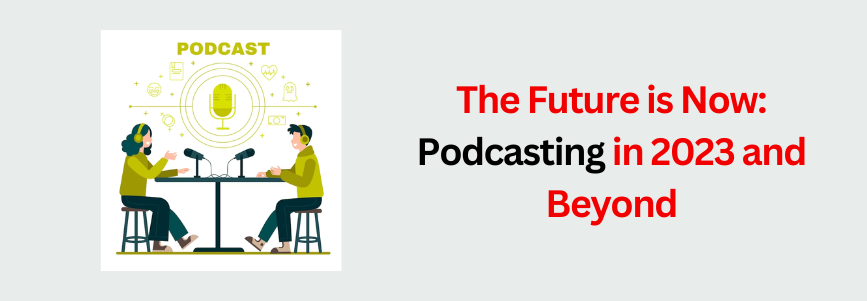Human voices can convey much more meaning through tone and inflection than printed words ever could. It’s why millions of Americans sat, fixated, listening to all kinds of radio programs, from adventure to comedy to drama to classical music concerts, news to farm reports, and so much more, during the Golden Age of Radio.
It is no secret that content marketers know how broadcast radio has evolved into television, television has evolved into cable, and cable has evolved into the internet of everything, so it is no wonder that broadcast radio has come full circle with podcasts, a new medium for storytelling that has been fueled by technological advances thanks to technological advancements.
It is important to note that the average podcast listener stays connected for approximately 22 minutes, which is one of the reasons why including podcasts in a long-form content marketing strategy is so powerful. It gives you the opportunity to build a deep, rich relationship with your target audience.
Introduction:
It has been shown by Edison Research that podcasting has reached mainstream America. According to Edison Research, podcasting is in a phase where it has hit its stride. It is estimated that millions of Americans listen to online radio on a regular basis, with nearly half of them familiar with the term “podcasting.” The following statistics may be of interest to you:
- In the last month, 32 million people listened to podcasts
- Over 14 percent of weekly podcast users listen to at least six podcasts each week
- In the past week, 6% of Americans over the age of 12 listened exclusively to online radio.
- Listeners to video podcasts make up 22%; listeners to audio podcasts make up 27%
- Online radio is listened to daily by 18% of smartphone users; 44% have listened to it once or more
- 29% have used iPod/MP3 players for in-car media consumption
- 12 hours/week on average people report time spent with all sources of online radio – double what it was in 2003
There has been a significant increase in podcast outlets, and podcasts have become a significant channel for the consumption of digital content (Apple’s iTunes app just surpassed one billion subscriptions for podcasts).
What is Podcasting?

As a reminder to our readers who are not familiar with podcasting as a content marketing tool, let’s take a step back. As part of a digital evolution of radio broadcasting, podcasting involves the creation of one or more audio or video files that are released episodically and can often be downloaded from the internet as a downloadable MP3 (but does not include music or movie downloads).
For marketers and brands, podcasting offers a clear and concise way to communicate their value propositions. With today’s on-the-go culture, podcasting offers businesses and brands the opportunity to share their story anywhere and anytime, thereby establishing authority in their industry and creating brand advocates along the way.
However, podcasting is not an immediate way to reach an enormous number of people, unless you’re a comedian, but it can be a powerful way to communicate a wide range of ideas, products, and information to a niche audience.
You need not worry about installing a new marketing campaign every time a new podcast is released, as RSS feed syndication simplifies the process of alerting your audience when a new podcast is available. This eliminates the need to introduce a new marketing campaign every time a new podcast is released.
You can use podcasting to further engage with your customers and prospects by providing an email address associated with your podcast so people can respond directly to the content. In order to create new content, you need to answer any questions or address feedback you have received. Most podcast hosting platforms and aggregators allow comments on episodes, and that feedback can be used to create new episodes in the future.
It is also easy to integrate podcasting into your company’s social media umbrella. For instance, blog posts can be enhanced with podcasts for readers who prefer audio, and then both the podcast and blog posts can be promoted on various social media platforms.
In order to connect with your customers in a more personal way, sound allows them to hear the emotion behind your words. Regardless of what you might have thought about podcasting in the past, podcasting is back. And it is booming.
What Marketers Are Saying About Podcasting
“Our culture has evolved so niche-oriented that you don’t even need 3 million people to listen to your podcast anymore.” Chris Hardwick, comedian and host of the Nerdist podcast. “If 10,000 people listen to the podcast, which isn’t a difficult number to reach, then you can make a difference, and you could literally change the world just by recording into a recorder.”
In addition to iTunes, several other apps that allow you to listen to podcasts directly outside of iTunes, such as TuneIn Radio, SoundCloud, Stitcher, and iHeartRadio, have given podcasts an entirely new audience.
Allen Weiner, an analyst at Gartner stated that podcasting is still only a small portion of overall listening, but we still need to invest in it. The Clear Channel president of digital, Brian Lakamp, told me that we need to be wherever our consumers are.
Pros of Podcasting
More people watch video podcasts

The mind wanders when you listen to an audio podcast, and you probably miss half of what’s being said. But a video grabs your attention more than just listening. You’ll be able to express yourself exactly what you want with video podcasting. Video content in social media feeds gets a lot of attention because humans are visual creatures. It is important for them to observe the speaker’s facial expressions, gestures, and body posture. Video is more likely to get people’s attention than audio.
Social media is dominated by video
On platforms like Facebook and Instagram, videos are muted by default. Podcast episodes with static images lose 90-95% of their listeners on YouTube in the first 90 seconds. Videos are the king of social media for capturing attention. Video podcasts can be a good way for you to reach the newer generation of podcast listeners. According to statistics, Gen-Z and Millennials spend their free time watching videos on social media apps.
Building trust starts with your face
When you put your face to your voice, people will become more familiar with you. And the more your audience knows you, the more likely they will trust you. Getting the audience’s trust isn’t as easy as you think. It requires consistency, integrity, and a commitment to publishing only great content. But you can get your audience to engage you through video podcasting better.
Reachability
You can easily find your video podcast on YouTube by searching for a preferred topic description.
Cons of Podcasting
- A video podcast requires more setup of the environment and equipment than an audio podcast. There are many factors that can affect your performance, including lighting, background, composition, personal grooming, framing, and even your dress code. You will need a high-definition camera, an external microphone, a tripod, etc. You will have to spend more on it than on recording an audio podcast, so it will be more expensive.
- A video file requires much more space than a sound file, and that means your hosting services will cost a lot more if your audience grows. Every new viewer will not only download your latest episode but will probably go back and download older episodes as well.
- It is a time-consuming process to create a video podcast, especially when you are a beginner at the technical aspects of the process. However, if you are passionate about podcasting, you can hire a video editor to help you with editing and other tasks. However, that won’t be of any help in the long run. In order to save money on a long-term basis if you decide to produce a video podcast, it is crucial that you have a thorough understanding of video podcasting and video editing.
Fine famous Indian Podcasts
The Mythpat podcast
Mithilesh Patankar, commonly known as the gamer ‘Mythpat’, created and hosts the Mythpat podcast. In weekly episodes, he interviews top gamers and influencers to entertain and educate his listeners about the latest news in the gaming industry as well as on the internet. By sharing his own experiences, he also paints a picture of what it is like to be an influencer.
Respectfully disagree by The Swaddle
An independent media company based in Mumbai, The Swaddle, hosts a podcast that discusses and examines health, gender, family, and culture issues. There are different topics covered in this weekly podcast, which is hosted by Srishti Malhotra and the conversations are both informative and entertaining.
The Ranveer Show
Among the top podcasts in the country, The Ranveer Show is hosted by Ranveer Allahbadia, also known as Beer Biceps who is also an influencer and a Youtuber who touches on a wide range of topics such as lifestyle, health, fitness, career guidance, motivation, entrepreneurship, and a lot more.
The Musafir Stories
The Musafir Stories podcast was launched in 2017 by Saif Omar and Faiza Khan and is a travel podcast based in India. In this podcast, they talk about various Indian travel destinations as well as talk to travelers who share their journeys, experience, travel tips, tricks, and hacks. This podcast brings together a diverse range of storytellers and explores beyond the picture-perfect itinerary to encourage people to travel.
On Purpose with Jay Shetty
It has been produced by a British Indian author, a former monk, and a purpose coach, Jay Shetty. His goal is to help people overcome day-to-day hardships and become more mindful of their lives. In this self-help podcast, which drops episodes every Monday and Friday, you will find fascinating conversations with insightful people from all over the world, who discuss a variety of topics.
Guidelines for Implementing a Podcast Successfully
Discover what your audience may be interested in by reviewing discussions on social media and blogs. Create profiles of typical listeners to help you create podcast content. Show your enthusiasm and knowledge about the topic. Don’t give a sales pitch or read from a script to alienate your audience.
If you want to stay on top of what your audience is discussing within your subject area, you need to keep an eye on what they are discussing. Taking time to listen to social media conversations will help you identify hot topics and questions.
You can create a podcast by repurposing content, like any content piece. You should interview the people you quoted in your ebook if you have written an e-book that has generated a lot of interest.
Take a look at the competition, and decide how to differentiate yourself from them. Think about how you can make their format better and provide your own unique perspective. Each episode’s length and frequency will depend on how much time you have available to plan, record, edit, and promote it.
The creation of quality long-form content takes time, so be realistic about your timeline. Once you’ve established a frequency, stick to it or your listeners won’t listen.
Depending on your audience, you can choose the best format. It can be a discussion of current industry news and advice, an interview with an industry thought leader or even a series of educational materials.
It’s important to stay consistent once you decide on the format of your podcast, whether it’s pre-recorded or live. Plan your content in such a way that it is dynamic and focused, but not so tightly planned that the podcast sounds forced. The best way to avoid reading the script is to write a broad outline like you would if you were giving a speech.
In every episode, you publish, provide links to other helpful resources so that your listeners can research the topic further. Providing real value to your listeners will keep them tuning in and recommending you to their friends and family.
Although starting a podcast program does not require much money anymore, it takes a lot of time and effort to create an excellent podcast. It is possible, however, to enhance your online brand by engaging a highly attentive audience with podcasts when done well and consistently.




